MEC Lasers & Beam Delivery
MEC provides the highest pulse energy laser systems at LCLS. A 1 J ultrashort-pule laser based on dual-stage chirped pulse amplification provides a high-contrast 800 nm, 40 fs, 1 J pulse for relativistic laser-matter interaction. This laser operates at 5 Hz and can be frequency doubled (400 nm), operate in uncompressed mode (1.5 J in 150 ps), or be delivered at low energy and higher repetition rate (few mJ @ 120 Hz). A nanosecond Nd:glass laser provides variable pulse shapes between 5 and 35 ns with power up to 10 GW, or 100 J in a 10 ns square pulse, for dynamic compression experiments.
Beam delivery platforms are available for focusing either the short or long pulse beam to target using rapidly installed components, reducing setup time. Some of these platforms are incorporated into standard configurations, which are detailed here. However, these platforms can be used for non-standard configuration experiments as well to facilitate the design of a successful layout. Discussion with the Instrument Team is strongly encouraged to reach an optimum setup with the available equipment in the hutch.
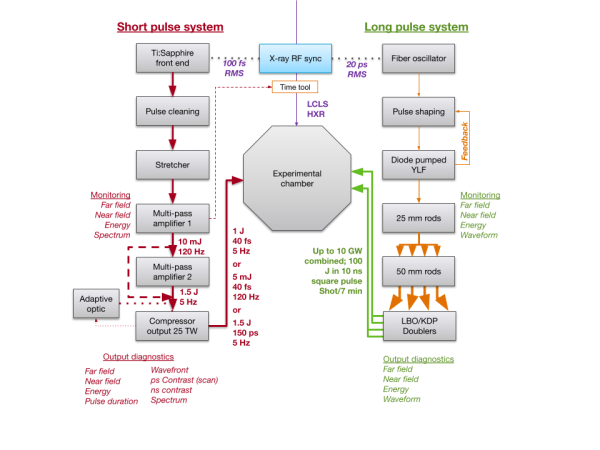
Long Pulse Laser System
The long pulse laser at MEC is designed to provide high-energy shapeable pulses at 527 nm. The front end of the system consists of a CW fiber oscillator operating at 1053 nm, which is injected into a programmable electro-optical (EO) modulator and shaped to the desired pulse length and shape. The output of the pulse shaper is fiber-coupled to a multi-pass diode-pumped Nd:Glass amplifier and temporally filtered using a pulse slicer, which minimizes the effects of amplified spontaneous emission in the pre-amplifiers. The pulse is subsequently amplified in ø25 mm Nd:glass rods to the J-level, at a rate of up to one shot per two minutes, and split into four arms. Each arm is further amplified in ø50 mm Nd:glass rods, and finally frequency doubled to 527 nm. In standard configuration, the four arms are polarization multiplexed into two beamlines and expanded to ø 72 mm to be focused to target. Following optimization in 2023, a combined pulse energy of up to 100 J in a 10 ns square pulse (maximum combined power capped at 10 GW) can now be delivered to target.
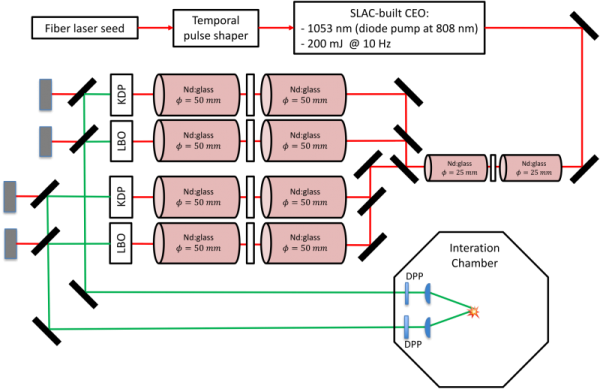
Energetics
In the long pulse front end, a 140 mW CW fiber source is modulated and then amplified in diode-pumped Nd:YLF heads, delivering >100 mJ of pulse energy at 10 Hz. The front end pulses are temporally filtered using a pulse slicer to minimize the effects of amplified spontaneous emission in the pre-amplifiers. The pulse is subsequently amplified to the Joule level (up to 1 shot per 2 minutes) and split into four arms. Each arm is further amplified by two 50 mm glass rods (total of eight rods) at a shot rate of 1 per 7 minutes. Finally, the arms are frequency-doubled to 527 nm using large aperture KDP and LBO crystals. LBO crystals are found to double slightly more efficiently than the KDP. After the second harmonic stages, the pulse energy per arm in operation is up to ~25 J for 10 ns square pulses, giving 100 J focused to target. The system has demonstrated ablation pressures exceeding 4 Mbar.
Pulse Shaping
In the front end the pulse is modulated using an IX Blue LiNbO3 EO device with a tap for closed-loop bias control, which helps to maintain pulse shape stability. The highland T400 waveform generator driving the modulator is controlled with in-house closed-loop optimization code in Python and updates instantaneously, allowing rapid convergence to a desired pulse shape in the front end. At 5 Hz, convergence is achieved in seconds.
While diverse waveforms are readily generated using the front-end closed loop system, the amplification stages significantly affect the final pulse shape. A good starting point can be established using a semi-empirical transfer function to converge at 5 Hz to the appropriate front end output for a given desired pulse shape, but the finishing touches require a few iterations on full energy shots at 1 shot/7 min.
A variety of waveforms can be generated for experiments. Figures 3 through 5 serve as examples of waveforms utilized in experiments at MEC, measured at the output of the long pulse laser. Pulse duration can be varied between ~5 and 35 ns. Maximum pulse energy will depend on the chosen shape, with maximum power limited to 10 GW for the safety of the optics.

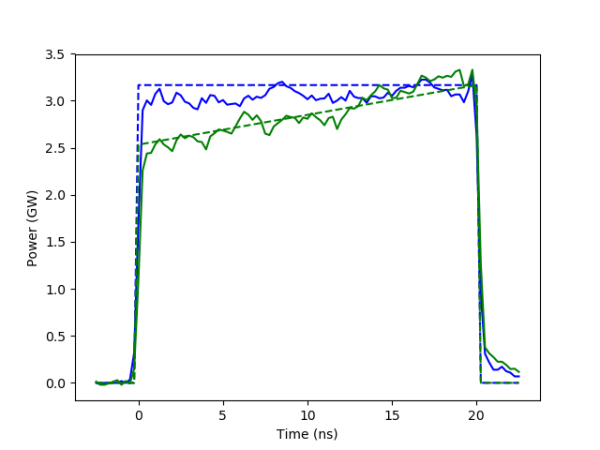
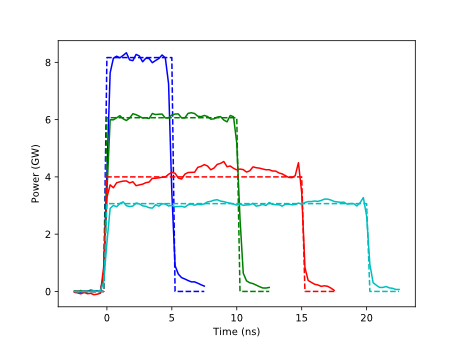
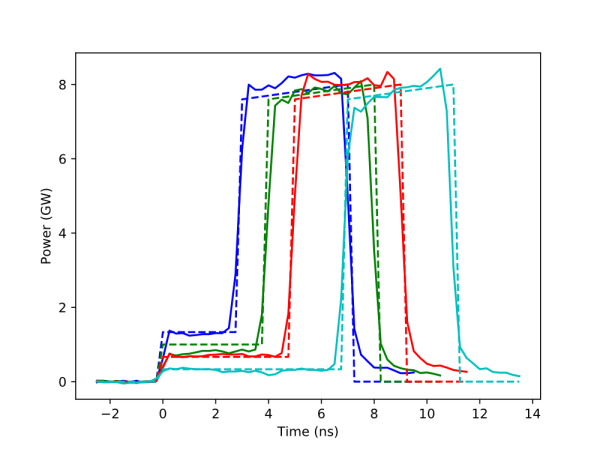
During experiments, the waveform of each arm is monitored separately and recorded for each laser shot, together with its calibrated energy.
Shot to Shot Stability
The upgrade in 2017 to a diode pumped front end has greatly improved the shot-to-shot energy stability of the long pulse laser as compared to the previous system. Example measurements are shown in Figure 5.

Focusing Optics and Far Field Beam Profiles
The two beam lines inside the target chamber are focused with 250 or 500 mm focal length lenses, with the 250 mm aspheric lenses being standard. Typically these lenses are paired with phase plates to produce large supergaussian focal spots of predefined size. For the 250 mm lenses these are nominally 150 mm, 300 mm and 600 mm. Example spot measurements with each of the phase plates are shown in Figure 6, using a log false color scale in the images for contrast.
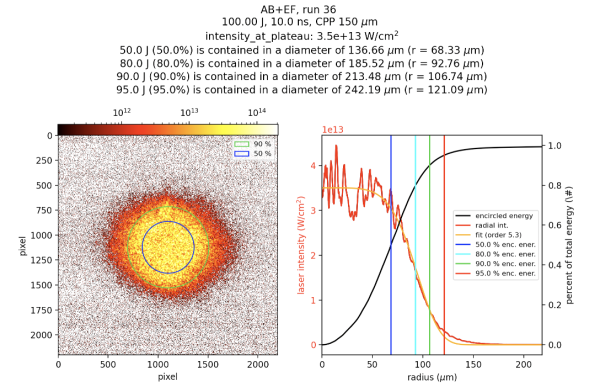
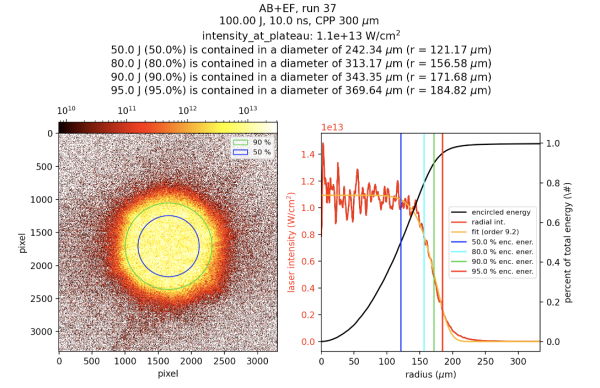
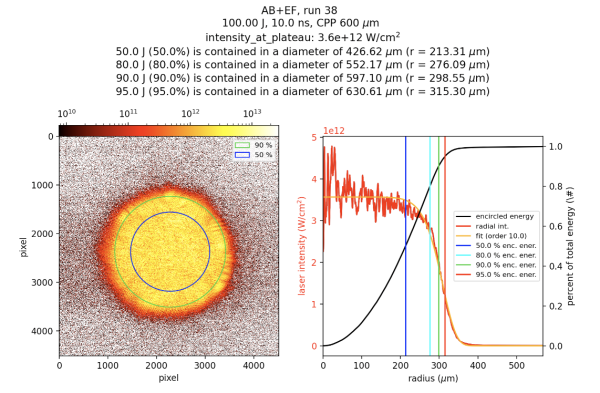
Diagnostics for Long Pulse Laser system
The diagnostic toolbox for the long pulse laser on every shot includes characterization of the pulse temporal profile and energy for each arm. The relative timing of the laser beams with respect to the x-ray beams is monitored with a resolution of about 20 ps. The focal spot on target is measured off-line at low energy before the run.
The long pulse laser beams can be transported in the chamber using a collinear or a perpendicular geometry vs the X-ray beam of the LCLS.
Collinear transport
Perpendicular transport
Short Pulse Laser System
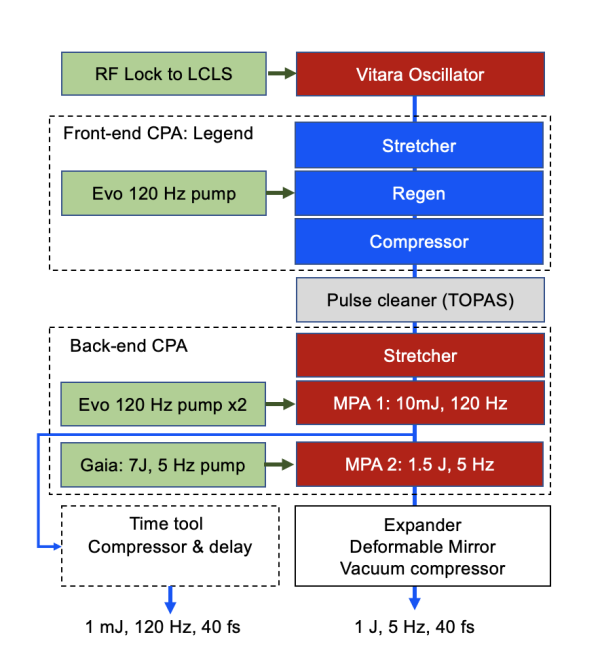
The short pulse laser at MEC is a double-CPA laser designed to operate at >25 TW peak power, with < 40 fs pulse duration and > 1 J per pulse. A schematic of the laser system is shown in Figure 1. A commercial CPA (Legend) system, seeded by an oscillator that is RF locked to LCLS, generates mJ-level compressed pulses, which are passed through an OPA pulse cleaning system before being stretched again for further amplification. The first bowtie amplifier operates at 120 Hz, matching the LCLS x-ray pulse rate, outputting >10 mJ per pulse. A second bowtie stage amplifies to >1.5 J at 5 Hz repetition rate. After compression, this yields > 1 J in 40 fs, for 25 TW peak power.
Pulse Duration
The final output has a pulse duration of approximately 35-55 fs, with a beam diameter of 65 mm, and an energy of 1 J. The compressor grating spacing can be adjusted to produce between 35 fs and 8 ps pulses. For pulses of longer duration, stretched pulses with 150 ps duration have been provided successfully.
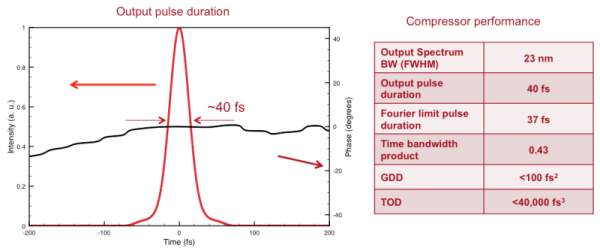
Wavefront Correction
After amplification, a 90 mm clear aperture deformable mirror (DM; cf. Figure 3), using feedback from an online wave front sensor (WFS), corrects the distortions produced in the laser chain. Focal spot and wave front measurements in the chamber allow for pre-correction of wave front distortion from the compressor and focusing optics. This system is necessary for producing the highest intensity at focus.
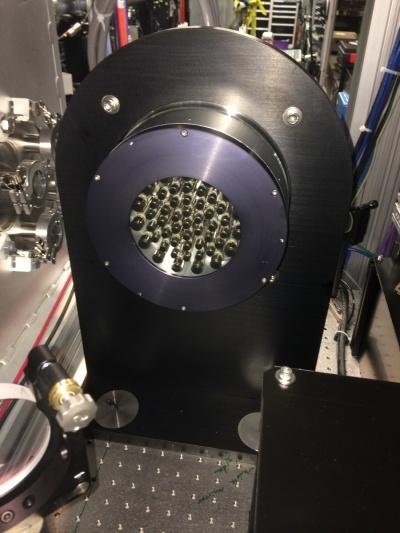
| Before Correction | After Correction | |
|---|---|---|
| RMS | 0.6 µm | 22 nm |
| P-V | 2.5 µm | 100 nm |
Table 3. Demonstrated wavefront correction of the DM/WFS closed loop system.
Focusing
The primary focusing optic for high intensity is a silver coated off-axis parabolic mirror (OAP) with effective focal length of 330.4 mm and an off-axis angle of 35.13.

Pulse Contrast
Nearly all user experiments using the multi-TW beam require excellent contrast to be successful. To achieve highest baseline pulse contrast, the short pulse laser system employs a double-CPA front end. After initial chirped pulse amplification of the oscillator pulses at 120 Hz, the beam is recompressed and passed through a nonlinear filter (with an OPA and SFG-based pulse cleaner [1] replacing XPW starting in Run 17) and then stretched again for final amplification. This filter removes prepulses and pedestal energy that builds up primarily in the laser front end. Measurements utilizing third order autocorrelation techniques revealed a contrast better than 107 in the > 3 picosecond range using a double CPA pulse cleaning system. To further increase this contrast, MEC can provide a 2nd harmonic stage that, in combination with dichroics, should theoretically achieve better than 1014 contrast beyond 3 ps, while sacrificing pulse energy (output ~300 mJ at 400 nm).
Timing Jitter and Synchronization with the LCLS X-ray Beam
Taking full advantage of the temporal resolution of femtosecond X-ray pulses and femtosecond optical lasers in pump-probe experiments requires timing measurement of a few 10 fs or better. LCLS has a pulse-to-pulse timing jitter relative to the accelerator radio-frequency (RF) distribution of approximately 60 fs RMS, integrated over a bandwidth of 0.1-100 kHz. The MEC short pulse laser oscillator is locked to the accelerator RF, with a distribution with similar or better timing jitter. Drifts in the laser beam path and RF distribution need to be controlled to approximately the 1 ps level.
The mode-locked seed laser oscillator operates at 68 MHz, the seventh sub-harmonic of the 476 MHz RF reference frequency of LCLS, which defines the fine (sub-picosecond) timing of laser pulses in the absence of configuration changes to the laser system.
The noise performance of the LCLS laser locking system was measured to have an RMS laser-to-RF-reference timing jitter of 25 fs between 100 Hz and 100 kHz. Below 100 Hz, phase noise is dominated by the noise of the linac RF reference.
Time Tool
To surpass the limitations of this jitter, experiments involving the fastest physical phenomena (e.g. transitions of core shell electrons) measure the relative timing between the laser and X-rays on a shot-by-shot basis by means of X-ray/optical cross-correlation techniques, referred to as the time tool, pictured in Figure 5. Ultrafast ionization by the x-ray beam in YAG windows allows its synchronization relative to the MEC laser to be precisely set. The ionization causes the window to become opaque showing definite before/after timing. By angling a window relative to the x-ray beam, the time tool gives synchronization to within a few fs. The time tool is cross-referenced to the target plane using another YAG window at the laser focus position, with a small f-stop temporarily inserted to spread the laser focus at the target plane. The time tool measures an RMS jitter of ~ 100 fs between the MEC laser and the x-ray beam.
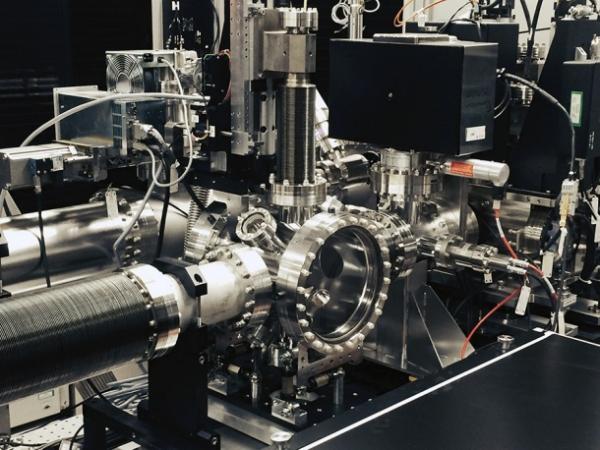
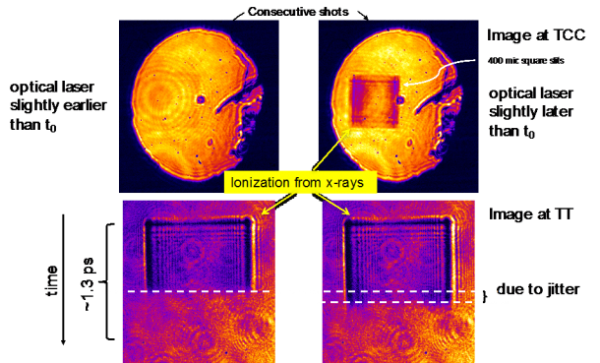
Diagnostics for the Short Pulse Laser system
The short pulse laser diagnostic suite includes a variety of devices that are accessible on-line and on demand. Here is a list of the common diagnostics already installed in the toolbox.
- On-shot diagnostics:
- Time tool (synchronization)
- Pulse energy
- Near-field beam profile
- Wavefront
- Equivalent plane focal spot
- Spectrum
- On-demand diagnostics (off-line)
- SPIDER
- 3rd order autocorrelation
- Far-field beam profile
- Motorized power meters
[1] “Pulse contrast enhancement via non-collinear sum-frequency generation with the signal and idler of an optical parametric amplifier,” vol. 114, no. 22, p. 221106, Jun. 2019.
Starting with run 22, the short pulse laser systems now benefits of a standardized beam delivery platform, greatly simplifying setup for compatible short pulse experiments. The platform is confined to the south east corner of the chamber, providing room for many diagnostics, including the MXI platform in both pre-target (phase contrast imaging) and post-target (direct imaging) configurations. The platform is compatible with several modes of the beam, abbreviated as follows:
- CFE1: Compressed and full energy at first harmonic (1ω)
- CFE2: Compressed and full energy at second harmonic (2ω)
- CLE2: Compressed and low energy at 2ω
- UFE: Uncompressed and high energy at 1ω
- ULE: Uncompressed and low energy at 1ω
CFE1 is the highest intensity mode, while CFE2 provides the highest contrast. CLE2 and ULE allow for up to 120 Hz repetition rate, and UFE is the highest pulse energy mode, providing about 1.5 J. UFE and ULE pulse durations are about 150 ps.
Details of standard delivery for these modes are given below:
Full aperture F/6: required for CFE1 and CFE2
The beam delivery layout at 45° is shown in Figure 3 below.
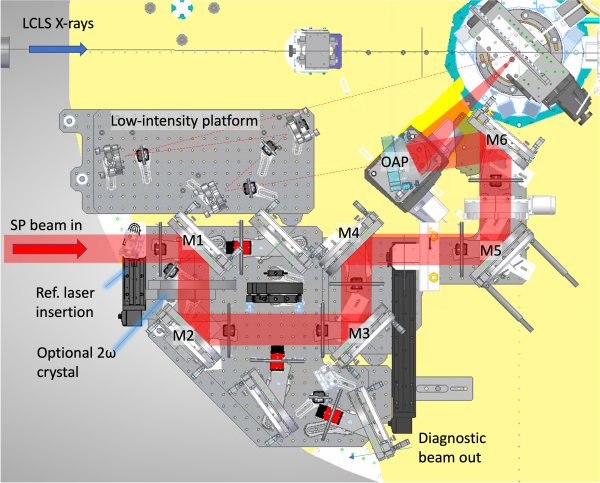
The beam enters the chamber through the south west port. The first beamsplitter let about 1% of the beam go through towards a near field/far field camera system measuring pointing jitter on shot (image saved in the DAQ). Then, the beam go through a 2ω conversion crystal for UHI2 or not (for CFE1). For CFE2, the next mirrors are all high-quality dichroics with 99.9% reflectivity for 2ω and 0.1% for 1ω. For CFE1, the reflectivity is 99.9% at 1ω. An motorized insertion energy meter measures the power with better than 10% accuracy, from 0.5W (0.1J) to 5W (1J). Then the beam is focused by a silver coated off-axis parabolic mirror (OAP) installed at one of the three discrete angle relative to the X-rays: 22.5°, 45° and 59°. The OAP is an f/6 and provides a spot of about 6x8 µm FWHM as seen in Figure 4. for the 1ω spot.
⚠️ Note that for 1ω full intensity shots the angle between target normal and laser focus direction must be 45° or more, to protect against back reflection damage.

Figure 5. shows typical jitter obtained over 1000 shots as well as the typical laser intensity fluctuations at TCC and under vacuum conditions.
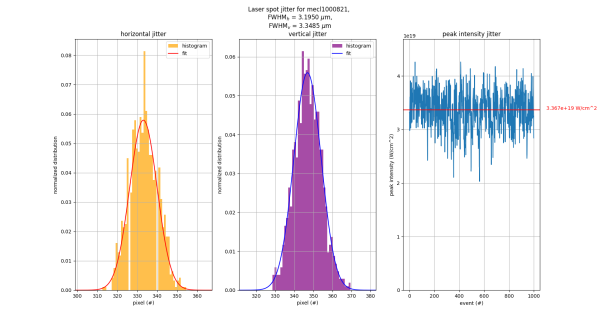
The laser spot at 2ω is shown in Figure 6.

Because the frequency conversion is done after the beamsplitter used for the near field/far field, this diagnostic is available for both CFE1 and CFE2 modes. And because the OAP is silver coated, the 3 angles of incidence are available for both CFE1 and UHI2 modes. It should be noted that at the moment, the imaging system used to characterize the spot needs to be installed from scratch. We invite users to discuss with the instrument team to decide the best path forward for this important diagnostics.
Low peak-power, long f-number focusing
The three low peak-power modes, CLE2, UFE, and ULE can be delivered in a smaller beam and focused with a high F/#, as shown in Figure 7.
The OAP module is removed to let a smaller platform holding a long focal length spherical mirror. While the beam size entering the chamber is a function of its energy (full beam size for the CFE, while it will be reduced in the laser enclosure for the CLE2 and ULE modes), the transport of the beam to the focusing optics does not change, allowing to reduce the time necessary for setup the various configurations.
